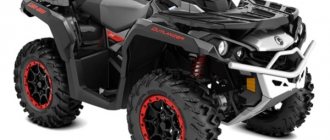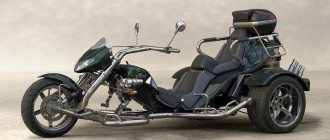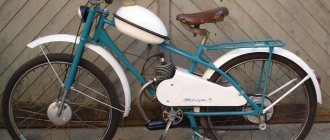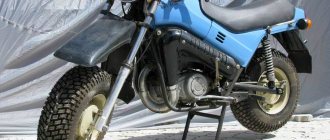Today, in the description of automobile engines, you can find not only power and torque values, but also prefixes: in-line, V-shaped and opposed, characterizing the arrangement of the cylinders. Despite the fact that each of these schemes is an evolutionary step in engine building, none of them have yet been abandoned. And all because they all have their pros and cons, which you also need to pay attention to when choosing a vehicle.
Engine history
The first patented internal combustion engine was the one developed in 1883 by Gottlieb Daimler and Wilhelm Maybach. It was a single-cylinder engine developing only 1.1 liters. With. Of course, we did not have to be content with the power of such motors. After all, cars were supposed to replace horse-drawn carriages, taking over all their tasks: transporting people, goods, and so on. Therefore, to increase the power of engines, they began to increase the working volume of the cylinder. But, as it turned out, there is a limit to everything. Along with the cylinder, it was necessary to enlarge the piston and connecting rod; the loads on these parts increased, and they also had to be taken into account during the design. In addition, the ignition of large volumes of air-fuel mixture in such an engine occurs with a certain pause, which is why it operates unevenly. In this case, it is necessary to install a heavy balancer, and then the structure becomes even heavier and additional energy is needed to set it in motion. As a result, single-cylinder engines became too massive, and the weight increased disproportionately to the power. This led to the fact that it became impossible to make the engine operate at high speeds, and, as is known, the lower the crankshaft rotation speed, the less its power.
TOP 5 BEST and WORST MERCEDES MOTORS
If we were talking about the end of the 20th century, then about the power units produced by the Mercedes-Benz division of Daimler-Benz AG, one could unequivocally say that, without being at the forefront of technological progress, they were the most reliable and indestructible engines, superior therefore the parameter of all its competitors. But the 21st century dictates its own laws and, introducing its generally accepted technical innovations and “bells and whistles” (compliance with environmental standards, reduced fuel consumption, the introduction of the latest control and safety systems), Mercedes-Benz engines have lost their positions in this matter to many other automakers.
In-line engine
Row diagram.
This scheme is used with a small number of cylinders (from two to six). The main advantage is that motors of this type are the easiest to balance. The disadvantage is its impressive length. It was soon decided that the crankshaft could move more than just one piston, and several more were added to one cylinder. The cylinders were placed in a row (this is the easiest way). 2-cylinder engines appeared first, and in 1890 the first 4-cylinder engine appeared. The power of this engine has already reached 5 liters. With. at 620 rpm, but both by today's standards and by the standards of that time this was not enough to move heavy equipment. Therefore, new engines were created, the number of cylinders reaching six, eight and even twelve. And here the manufacturers are faced with the next problem. Such engines required a large amount of free space under the hood. In addition, these engines, due to their weight, made the car heavier, thereby worsening its stability and controllability. Engineers' thoughts turned to creating a more compact engine... By the way, today in-line engines can be found with a maximum of six cylinders. Basically, 4-cylinder engines are built today according to this scheme, since they are the simplest to manufacture.
Choosing an electrical system - AC or DC?
Which motor to choose when ordering an electric vehicle - AC or DC?
In the familiar world of internal combustion engines, there are a variety of types: in-line, V-shaped, opposed, rotary, etc. And the only “best” type of engine has not yet been chosen. Different types of motors exist to meet different needs, such as price or performance. This also applies to electric motors. When choosing a golf cart, electric bus or electric truck, one of the most important technical parameters is the type and power of the motor. And if everything is clear with the power - it should be sufficient to solve the tasks assigned to the golf cart, then with the type of motor it is less obvious. There are 2 types on the market - DC motors (brush-commutator direct current motors) and AC motors (synchronous alternating current motors). Sometimes you can find brushless BLDC motors or asynchronous AC motors, but these are rather exotic in the case of low-speed electric vehicles, so we will not add them to the comparison.
DC motors
Many electric vehicle manufacturers, including American ones, still offer equipment with brushed DC motors, usually in the most inexpensive configurations.
Let's try to understand whether it's worth saving on this. Strengths of the motors: • Brush DC motors with series excitation of windings have high torque at start and low speeds. • DC motors are relatively compact and light weight • DC motors are easy to control and require a cheaper controller
But here are the weaknesses of brushed DC motors: • The DC motor has a brush-commutator assembly, which is subject to increased wear of the graphite brushes and commutator. Literally - the brushes wear out on the commutator, over time they require replacement and tend to break. • DC motors, for long service life, must be equipped with a soft motor start device in order to protect the rotor windings from combustion during inrush current • The windings on DC stators generate a lot of heat, which requires complex technologies for dissipation, including stator fins, oil cooling, etc. .d. • The torque of the DC motor decreases with increasing speed
V-engine
V-shaped pattern.
This arrangement allows you to significantly reduce the length of the motor, but at the same time increases its width. The most common are V6 and V8. In fact, the idea of a compact engine was patented even before the multi-cylinder monsters appeared. This engine was created in 1889. It had two cylinders with a camber angle of 17 degrees and developed 1.6 liters. With. at 900 rpm. The V-twin layout was essentially two engines located next to each other and driving one common crankshaft. This arrangement made it possible to reduce the length of the motor by almost half.
In the automotive industry, the first V-shaped engine appeared in 1905. It was an aircraft engine built by French inventor Leon Levavasseur. At first, engines built according to this design were installed on trucks and buses, and over time they began to be found under the hoods of passenger cars. And yet, despite the many positive qualities of such a scheme, it has not replaced the in-line one. After all, where there are advantages, there are always disadvantages. Mainly this is a more complex design (two gas distribution mechanisms instead of one), and, consequently, the complexity of production and further repairs. In addition, although the overall dimensions have decreased in length, the motors have “grown” in width.
Pistons apart
The cylinders in this engine are located at an angle in the form of the Latin letter V. The piston connecting rods, just like in-line engines, are located on the same crankshaft, but closer, which makes it possible to reduce the overall length of the engine by almost half and place a powerful engine inside a small motorcycle frame or hide it a four-cylinder unit in the tiny engine compartment of the ZAZ-965. Thanks to the V-shaped layout, the eight-cylinder engines produce 400 hp. and fit more easily into a two-door Chevrolet Camaro or Ford Mustang. The compact dimensions helped to increase the rigidity of the engine housing elements, and the angled arrangement of the cylinders made it possible to reduce the engine height. However, wide V-shaped engines occupy the engine compartment tightly and are more labor-intensive to repair. Two cylinder heads, a more complex gas distribution and exhaust system.
The V-shaped “six” is now the most common engine of this design, while V8s are dying out under the pressure of environmental standards
Boxer engine
The boxer engine is a V-twin engine with a camber angle of 180 degrees.
The main advantage is the smallest height and, as a result, a decrease in the center of gravity of the car. Disadvantage: uneven wear. Mostly 4- and 6-cylinder engines are found. One type of V-twin engine that receives special attention is the boxer engine. Essentially, this engine is V-shaped with a cylinder angle of 180 degrees. Basically, such motors are widely used on motorcycles. The transverse (to the direction of movement) placement of the engine improved the cooling of the cylinders by the incoming air flow. However, it also found a place in the automotive industry. From 1938 to 2003, boxer engines were installed on the Volkswagen Beetle, all for the same reason of better cooling (the engine had an air cooling system).
In the 60s, manufacturers busily began developing front-wheel drive cars. Cars with this design, compared to rear axle drive, had advantages on slippery surfaces, and were also simpler and cheaper to manufacture. But as it turned out, not everything is so simple. Due to the heaviness of the engines, front-wheel drive cars of that time could not boast of good handling and balance in corners. Designers began to lower the center of gravity of the engines; they mainly achieved this by “laying the engines on their sides.” And while some automobile companies were experimenting with the location of the engine, Japanese engineers from Subaru in 1966 introduced their first front-wheel drive car, the Subaru-1000, which was equipped with a boxer engine located along the axis of the car. Due to the horizontal arrangement of the engine cylinders, the vehicle's center of gravity has been significantly lowered, thereby improving the stability and controllability of the vehicle.
However, such motors have not found widespread use. This is due to a number of disadvantages: uneven wear of the cylinders (due to the point distribution of loads, the cross-section of the cylinder becomes elliptical over time), high oil consumption and poor crankcase ventilation. Boxer engines today can be found in Subaru and Porsche cars, for which handling comes first.
About forces and moments
In general, a piston internal combustion engine cannot operate without vibrations - that’s how it’s designed. But we need to fight them, and not only to improve passenger comfort. Strong unbalanced vibrations can cause destruction of engine parts - with all the consequences that fly out and fall out from there...
Why do vibrations occur? First, in some engine designs, cylinder flashes occur unevenly. Designers avoid such schemes whenever possible or try to make the flywheel more massive - this helps smooth out torque ripples. Secondly, as the pistons move up and down, they either accelerate or slow down, which creates inertial forces - akin to the forces that make car passengers bow when braking or press them into the backs of their seats when accelerating. Thirdly, the connecting rod in the engine does not move up and down at all, but makes a complex movement. And the reciprocating movement of the piston from top dead center to bottom also cannot be described by a simple sinusoid.
- The inertial forces from two masses rotating on the same shaft at a distance from each other create a free moment.
- In the simplest motor there are free forces of inertia, but no torques. There is only one cylinder.
Therefore, among the inertial forces there appear components with double, triple, quadruple crankshaft rotation frequency... These so-called inertial forces of higher orders are usually neglected - they are very small compared to the main inertial force (which was assigned the first order). The exception is second-order inertial forces, which have to be taken into account. Plus, pairs of forces applied at a certain distance form moments - this happens when inertial forces in neighboring cylinders are directed in different directions.
What can be done to balance forces and moments? Firstly, you can choose a motor design in which the cylinders and cranks of the crankshaft are located in such a way that the forces and moments mutually balance each other - they will always be equal and directed in opposite directions.
A striking representative of the extinct tribe of cars with an in-line eight is the 1930s Alfa Romeo 8C model.
What if none of the balanced schemes are suitable - for example, for layout reasons? Then you can try to position the crankshaft journals differently and use all sorts of counterweights that create forces and moments equal in magnitude, but opposite in direction to the main balanced forces. This can sometimes be done by placing counterweights on the engine crankshaft. And sometimes - on additional shafts, which are called counter-rotation balance shafts. They are called that because they spin in the opposite direction than the crankshaft. But this complicates and increases the cost of the engine.
To make it easier to describe the degree of balance of different engines, we have prepared a summary table. Self-balanced forces and moments are highlighted in green, and free ones are highlighted in red (those that are not balanced and break free pass through the supports of the power unit onto the car body).
What happens? Of the common types of engines, only two are absolutely balanced - in-line and opposed "six". Now do you understand why BMW and Porsche hold on to such engines so tightly? Well, we have already mentioned the reasons why others refuse them. Now let's take a closer look at the remaining schemes.
Porsche water-cooled six-cylinder boxer engine. To save money, there are identical heads on the left and right sides of the block, so chain drives of the camshafts had to be installed both at the front and at the rear.
VR - in-line-biased engine
VR-shaped scheme.
Motors with a small camber angle (about 15 degrees). This angle made it possible to install both banks of cylinders in one cylinder block, which made it possible to reduce not only the length, but also the width of the engine. The main disadvantage is the additional shafts and unusual timing design, which is why it is very expensive to produce. Another type of cylinder arrangement includes an in-line-displaced engine, designated by the index VR. This engine is a combination of V-twin and in-line engines. The pistons move at an angle of 15 degrees, which allows them to be located in the same cylinder block. When creating this engine, the designers tried to make maximum use of the advantages of the V-shaped and in-line engine: small overall dimensions (both in length and width), ease of manufacture. But creating the perfect motor was not an easy task. These motors have high thermal stress. Thin walls between the rows of cylinders do not allow for a sufficient number of channels for coolant, as a result of which these engines are less resistant to overloads.
Disadvantages of V6
V-shaped engines with the same number of cylinders as their in-line counterparts are not at all as well balanced. They are essentially created from two inline 3-cylinder engines, therefore, any V6 requires special balancing mechanisms that will balance the engine while it is running. Without balancing shafts, the crankshaft would be subject to enormous loads created by the reciprocating movements of the parts.
Engine balancing deteriorates as its displacement increases and the cylinder size increases (as the piston mass increases). Counterweights then also add complexity to the engine design and manufacturing process, increasing its cost. For example, a DOHC V6 must have 4 camshafts and 24 valves, and additional balancing shafts located in each head will only add to the complexity of its maintenance.
For many years, V6 engines killed the straight six, also known as the I6, and this development in engine packaging was destined for oblivion. But Mercedes-Benz has achieved resurrection. This brought back the straight six in the M256, an all-new engine design to replace many of its V6s.
Thus, it was the low development costs of the engine and its good balance that ensured that this old engine design was revived using new technical solutions.
The 48V electrical system provides four times the power of its 12V predecessor at the same current and allows for the electrification of key components (such as the air conditioning compressor) or the introduction of new technologies (such as the electric auxiliary compressor) and therefore saving fuel. The low voltage system does not require the additional safety architecture of the high voltage network.
Source
W engine
W-shape.
There are two layout options - three rows of cylinders with a large camber angle (e) and a combination of two VR-shaped schemes (e). Currently, W8 and W12 are produced. The pursuit of power led to the birth of engines built according to the W scheme. These are, in fact, two VR engines, the angle between which is 72 degrees, or three in-line ones. The main disadvantage of such engines is that there are twice as many connecting rods on the crankshaft as on the V-shaped one, and four times! more than in a row. The connecting rods are made thin, and since these parts are among the most loaded in the engine, as a result they begin to bend at high speeds. Such motors are not created for mass use. They can only be found on sports cars.
Crankshaft and types of its structures (Part 2).
crankshaft designs . See the beginning of this article here.
On a four-cylinder engine, the angle between pairs of crankpins is 180 degrees; on a six-cylinder engine, the pairs are rotated 120 degrees. In this case, the shaft remains symmetrical along the middle journal, just like in a four-cylinder engine; such shafts can be called “symmetrical”. Such shafts do not create unnecessary vibrations even in the absence of counterweights. That is, to ensure balance in an engine with “symmetrical” shafts, it is enough to select the same mass of connecting rods. In other systems, the mass of the connecting rods must strictly correspond to the counterweights. Here, only the mass of the lower part of the connecting rod is considered, since it is this part that performs the rotational movements and only this mass must be balanced by the counterweight. How to determine the mass of the lower head of the connecting rod, we will talk about this in more detail in the topic about connecting rods.
If we compare the crankshaft of an in-line four-cylinder engine and a six-cylinder engine, it is generally accepted that the shaft of a six-cylinder engine is completely balanced. This is precisely the reason for installing it on high-class cars. In-line six-cylinder engines can be found in cars from the following companies: MERCEDES-BENZ, BMW, VOLKSWAGEN, OPEL, VOLVO, NISSAN, TOYOTA.
On in-line six-cylinder engines, seven-bearing crankshafts are used; four-bearing shafts are used much less frequently due to insufficient strength.
Sometimes, due to the layout of the auxiliary units, on an inline six-cylinder engine you can find a crankshaft in which one of the counterweights has a reduced radius. To obtain the required mass of the counterweight, an additional counterweight of the required mass is riveted to it.
Some companies, in particular HONDA, VOLVO, MERCEDESBENZ, AUDI, install in-line five-cylinder engines in their cars. If we consider the crankshaft installed on a five-cylinder engine in terms of balance, then it occupies a middle place, between the shaft of a four and six cylinder engine. Again, when compared with 4 and 6 cylinder engines, the shaft of a 5 cylinder engine is more difficult to repair. It has six supports, all the connecting rod journals are rotated from each other at an angle of 72 degrees and it no longer has symmetry.
Inline six-cylinder engines are longer, so V-twin engines were invented that were half as long with the same number of cylinders. The crankshaft of a six-cylinder V-engine has a complex configuration, where the connecting rod journals are usually offset from each other by 60 degrees. It has 4 bearings and, like a five-cylinder crankshaft, it lacks symmetry, which also makes it difficult to repair.
The shafts of six-cylinder V-engines are perfectly balanced by selecting the masses of connecting rods and counterweights. But at large volumes (above 3.5 liters), imbalance appears, and there you have to install a balance shaft.
For high-class cars from MERCEDES-BENZ, FORD, GM, CHRYSLER, later BMW, AUDI, NISSAN, TOYOTA joined them, V-shaped eight-cylinder engines are installed. A feature of the crankshaft of an eight-cylinder V-engine is that there are two connecting rods located on one crankpin, and the crankpins themselves are shifted relative to each other by 90 degrees. As a result, it turned out that the shaft of an eight-cylinder engine was easier to repair than a six-cylinder V-shaped engine or an in-line five-cylinder engine.











